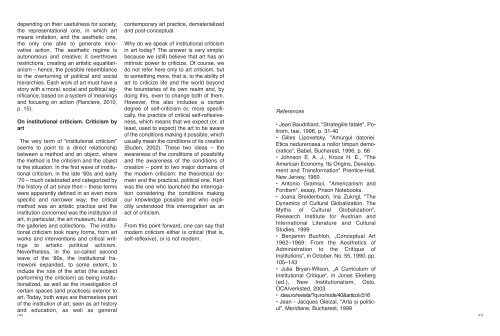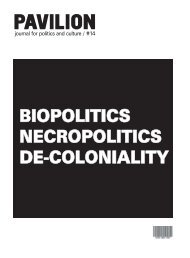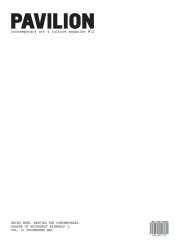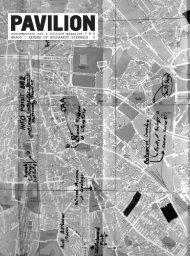Download pdf version of issue no. 16 (4 Mb) - Pavilion
Download pdf version of issue no. 16 (4 Mb) - Pavilion
Download pdf version of issue no. 16 (4 Mb) - Pavilion
Create successful ePaper yourself
Turn your PDF publications into a flip-book with our unique Google optimized e-Paper software.
depending on their usefulness for society,<br />
the representational one, in which art<br />
means imitation, and the aesthetic one,<br />
the only one able to generate in<strong>no</strong>vative<br />
action. The aesthetic regime is<br />
auto<strong>no</strong>mous and creative; it overthrows<br />
restrictions, creating an artistic equalitarianism<br />
– hence, the possible resemblance<br />
to the overturning <strong>of</strong> political and social<br />
hierarchies. Each work <strong>of</strong> art must have a<br />
story with a moral, social and political significance,<br />
based on a system <strong>of</strong> meanings<br />
and focusing on action (Ranciere, 2010,<br />
p. 15).<br />
On institutional criticism. Criticism by<br />
art<br />
The very term <strong>of</strong> “institutional criticism”<br />
seems to point to a direct relationship<br />
between a method and an object, where<br />
the method is the criticism and the object<br />
is the situation. In the first wave <strong>of</strong> institutional<br />
criticism, in the late ‘60s and early<br />
’70 – much celebrated and categorized by<br />
the history <strong>of</strong> art since then – these terms<br />
were apparently defined in an even more<br />
specific and narrower way; the critical<br />
method was an artistic practice and the<br />
institution concerned was the institution <strong>of</strong><br />
art, in particular, the art museum, but also<br />
the galleries and collections. The institutional<br />
criticism took many forms, from art<br />
works and interventions and critical writings<br />
to artistic political activism.<br />
Nevertheless, in the so-called second<br />
wave <strong>of</strong> the ‘80s, the institutional framework<br />
expanded, to some extent, to<br />
include the role <strong>of</strong> the artist (the subject<br />
performing the criticism) as being institutionalized,<br />
as well as the investigation <strong>of</strong><br />
certain spaces (and practices) exterior to<br />
art. Today, both ways are themselves part<br />
<strong>of</strong> the institution <strong>of</strong> art, seen as art history<br />
and education, as well as general<br />
[<strong>16</strong>]<br />
contemporary art practice, dematerialized<br />
and post-conceptual.<br />
Why do we speak <strong>of</strong> institutional criticism<br />
in art today? The answer is very simple:<br />
because we (still) believe that art has an<br />
intrinsic power to criticize. Of course, we<br />
do <strong>no</strong>t refer here only to art criticism, but<br />
to something more, that is, to the ability <strong>of</strong><br />
art to criticize life and the world beyond<br />
the boundaries <strong>of</strong> its own realm and, by<br />
doing this, even to change both <strong>of</strong> them.<br />
However, this also includes a certain<br />
degree <strong>of</strong> self-criticism or, more specifically,<br />
the practice <strong>of</strong> critical self-reflexiveness,<br />
which means that we expect (or, at<br />
least, used to expect) the art to be aware<br />
<strong>of</strong> the conditions making it possible, which<br />
usually mean the conditions <strong>of</strong> its creation<br />
(Buden, 2002). These two ideas – the<br />
awareness <strong>of</strong> the conditions <strong>of</strong> possibility<br />
and the awareness <strong>of</strong> the conditions <strong>of</strong><br />
creation – point to two major domains <strong>of</strong><br />
the modern criticism: the theoretical domain<br />
and the practical, political one. Kant<br />
was the one who launched the interrogation<br />
considering the conditions making<br />
our k<strong>no</strong>wledge possible and who explicitly<br />
understood this interrogation as an<br />
act <strong>of</strong> criticism.<br />
From this point forward, one can say that<br />
modern criticism either is critical (that is,<br />
self-reflexive), or is <strong>no</strong>t modern.<br />
References<br />
• Jean Baudrillard, "Strategiile fatale", Polirom,<br />
Iasi, 1996, p. 31-40<br />
• Gilles Lipovetsky, "Amurgul datoriei.<br />
Etica nedureroasa a <strong>no</strong>ilor timpuri democratice",<br />
Babel, Bucharest, 1996, p. 68<br />
• Johnson E. A. J., Kroos H. E., "The<br />
American Eco<strong>no</strong>my. Its Origins, Development<br />
and Transformation" Prentice-Hall,<br />
New Jersey, 1960<br />
• Antonio Gramsci, "Americanism and<br />
Fordism", essay, Prison Notebooks.<br />
• Joana Breidenbach, Ina Zukrigl, "The<br />
Dynamics <strong>of</strong> Cultural Globalization. The<br />
Myths <strong>of</strong> Cultural Globalization",<br />
Research Institute for Austrian and<br />
International Literature and Cultural<br />
Studies, 1999<br />
• Benjamin Buchloh, „Conceptual Art<br />
1962–1969: From the Aesthetics <strong>of</strong><br />
Administration to the Critique <strong>of</strong><br />
Institutions“, in October, No. 55, 1990, pp.<br />
105–143<br />
• Julia Bryan-Wilson, „A Curriculum <strong>of</strong><br />
Institutional Critique“, in Jonas Ekeberg<br />
(ed.), New Institutionalism, Oslo,<br />
OCA/verksted, 2003<br />
• idea.ro/revista/?q=ro/<strong>no</strong>de/40&articol=5<strong>16</strong><br />
• Jean - Jacques Gleizal, "Arta și politicul",<br />
Meridiane, Bucharest, 1999<br />
[17]








